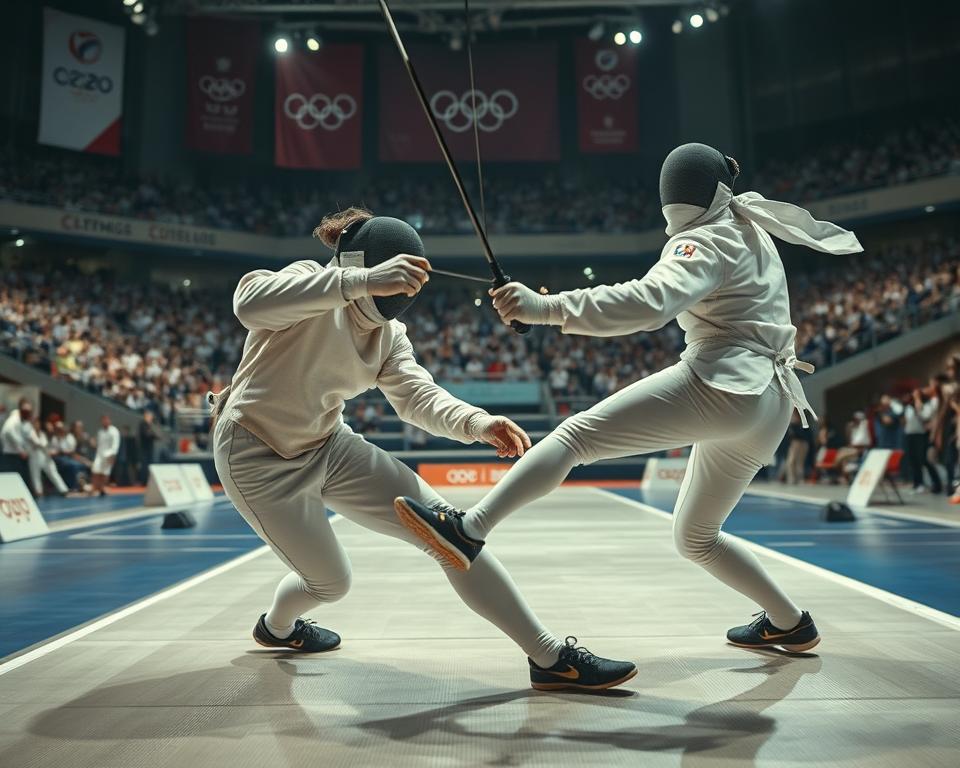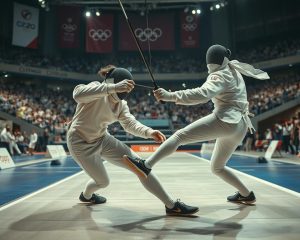Olympic Fencing Accident: What You Need to Know

Olympic fencing is a mix of skill, strategy, and intensity. But, it also comes with big injury risks. This article will cover the dangers of fencing, safety steps for athletes, and lessons from a recent Olympic accident.
Fencing is an exciting sport that demands quick reflexes, precise moves, and focus. The Olympic fencing shows are thrilling, but the risks are real. It’s important to know the dangers and how to stay safe for athletes and fans.
We will look into how fencing athletes stay safe, the injuries they might get, and how safety is being improved. By exploring a recent Olympic fencing accident, we aim to share important info that helps protect athletes.
Read more interesting information at ::googrekas
Understanding the Dangers of Fencing
Fencing is a thrilling sport that comes with risks. Athletes face serious injuries due to its dynamic nature and sharp blades. Safety is key in this sport.
Fencing: A Thrilling Yet Risky Sport
The fast pace and intense demands of fencing lead to injuries. These can range from muscle strains to severe cuts. Quick reflexes and precise footwork increase the risk of sprains, fractures, and concussions.
Safety Measures in Olympic Fencing
To reduce risks, fencing has strict safety rules. Fencers wear protective gear like jackets, masks, and gloves. There are also rules to keep the sport safe and fair, with penalties for breaking them.
Even with safety measures, fencing requires alertness and training. Fencers must know the rules and wear the right gear. This ensures their safety and that of their opponents.
“Fencing is a sport that requires a delicate balance between thrill and caution. While the adrenaline rush is undeniable, athletes must always prioritize their well-being and adhere to the safety protocols put in place.”
By understanding the dangers and taking steps to prevent them, fencing can be both thrilling and safe. As the Olympic fencing event nears, it’s important for athletes and spectators to value safety in this exciting sport.
The Fencing Accident Olympics
The 2016 Rio Olympics had a shocking fencing accident. It happened during a men’s épée semifinal match. Two fencers collided, causing a severe injury that stunned everyone.
Nikolai Novosjolov of Estonia and Gauthier Grumier of France were in a tense match. Their blades crossed, and Novosjolov’s blade went through Grumier’s gear. This caused a deep cut in Grumier’s leg, leading to a lot of blood loss.
“It was a freak accident, something we had never seen before in the sport of fencing. The safety of our athletes is of the utmost importance, and we will thoroughly investigate this incident to ensure it never happens again.”
Quick action was taken by the Olympic staff and doctors. They gave Grumier emergency care and took him to the hospital. The match was stopped, and all athletes were checked out.
This fencing accident at the Olympics showed the risks of the sport. It also pointed out the need for better safety gear and training. The fencing world is working hard to keep athletes safe as the sport changes.
After the incident, there was a big review of fencing safety. They looked at how to make protective gear better, change rules, and improve training. The fencing community wants to make sure such accidents don’t happen again.
Fencing Injury: Types and Causes
Fencing is an exciting Olympic sport with risks. Athletes must balance the thrill of competition with safety. This section looks at common fencing injuries and their causes.
Common Fencing Injuries
Fencing injuries can be minor or serious. The most common ones are:
- Cuts and lacerations on the hands, arms, and torso from the blade
- Muscle strains in the legs from dynamic movements
- Ankle and knee sprains from quick changes in direction
- Contusions and hematomas from hitting the opponent’s blade or body
Preventing Fencing Injuries
To lower the risk of fencing injuries, we need a comprehensive approach. This includes proper training, using protective gear, and following safety rules. Key strategies for fencing injury prevention and fencing safety are:
- Training programs that focus on technique, footwork, and conditioning
- Enforcing rules on protective gear like masks, gloves, and armor
- Checking fencing equipment regularly to make sure it’s safe
- Education campaigns to promote safety among fencers and officials
Knowing about fencing injuries and taking steps to prevent them helps keep fencing safe. This way, the sport can continue to grow while keeping its athletes safe.
| Type of Injury | Causes | Prevention Strategies |
|---|---|---|
| Cuts and Lacerations | Contact with the blade, improper technique | Proper protective equipment, technique training |
| Muscle Strains and Sprains | Sudden movements, poor conditioning | Comprehensive physical training, warm-up exercises |
| Contusions and Hematomas | Impact with opponent’s blade or body | Strict enforcement of safety rules, use of protective gear |
Olympic Fencing: A Closer Look
The sport of Olympic fencing has a long history, dating back to the 16th century. It’s a thrilling sport that demands fencing athletes to be quick, precise, and strategic. They face off in intense duels, testing their skills.
There are three main types of fencing: foil, epée, and sabre. Each has its own rules and techniques. Foil fencers aim for the torso, while epée fencers can hit anywhere on the body. Sabre fencers go for the upper body with quick strikes.
To make it to the Olympics, fencing athletes train hard. They work on their physical fitness, learn their weapon’s details, and build mental strength. This helps them perform well under pressure.
| Fencing Discipline | Target Area | Unique Techniques |
|---|---|---|
| Foil | Torso | Controlled, precise strikes |
| Epée | Entire body | Powerful, expansive movements |
| Sabre | Upper body | Rapid, dynamic attacks |
The hard work and talent of Olympic fencing athletes are amazing. They show what humans can achieve and entertain fans worldwide.
“Fencing is a physical manifestation of the human mind’s ability to strategize, adapt, and respond in the face of an adversary.”
Fencing Safety: Rules and Regulations
Olympic fencing is a thrilling sport that needs strict rules for athlete safety. These rules help protect fencers from harm, letting them compete safely and with confidence.
Fencing Rules for Athlete Protection
The core of fencing safety lies in its rules. Key safety measures include:
- Using approved protective gear like jackets, masks, and gloves to lower injury risks.
- Rules for handling weapons, including checking and keeping gear in good condition to avoid accidents.
- Clear guidelines on where to aim and what actions are not allowed, like hitting above the shoulders or below the waist.
- Severe penalties for breaking rules, like being disqualified or suspended.
- Quick medical support and emergency plans for any bout incidents.
These fencing rules are always being checked and updated. This keeps the sport safe for everyone.
“Fencing is a sport that requires intense focus and precision, and the safety of the athletes is of paramount importance. The rules and regulations in place are designed to protect the fencers while allowing them to compete at the highest level.”
Following these strict rules makes Olympic fencing safe for athletes and fans. Everyone can enjoy the sport knowing it’s done safely and responsibly.
Fencing Equipment: Ensuring Maximum Safety
In the exciting sport of fencing, the right equipment is key to keeping athletes safe. Every piece, from the blades to the protective gear, is carefully made and kept up to reduce injury risks. It’s vital to know how important fencing gear is for the safety and health of the athletes.
The main tool in fencing is the foil, epee, or sabre. These blades are tough yet flexible, letting for precise hits while keeping serious injuries low. It’s crucial to check and test the blades often to keep them safe and working right during matches.
Protective gear is also a must for fencers. The fencing mask protects the head and face from direct hits. The clothing, including the jacket, pants, and gloves, is made to absorb and spread out the force of hits. This keeps the athlete’s body safe from getting hurt.
Looking after the fencing gear is just as important as using it. Cleaning it well, checking it often, and replacing any broken or old parts are key steps. Following the rules and advice from the makers helps keep the gear safe and effective for the athletes.

When aiming for the top in fencing, keeping the fencers safe is the main goal. By knowing how fencing gear works and how to keep it in good shape, we see the big effort to keep this exciting sport safe.
Fencing Tournaments: Maintaining High Standards
Fencing tournaments, like the Olympic ones, are known for their strict safety rules. These rules protect the athletes. Event organizers work hard to keep everyone safe in fencing tournaments and fencing competitions.
Rigorous Safety Protocols in Fencing Competitions
At fencing tournaments, following the sport’s rules is a must. These rules help prevent injuries. Officials make sure everyone sticks to the rules. Also, all fencing safety gear must be certified and checked often.
- Enforcement of fencing rules and regulations
- Mandatory use of certified fencing equipment
- Regular equipment inspections
- Presence of trained medical personnel on-site
Also, fencing tournaments have medical teams ready to help if someone gets hurt. This way, any injury can be dealt with quickly and safely. It keeps the athletes safe.
“Maintaining the highest standards of safety in fencing tournaments is of paramount importance. The well-being of our athletes is our top priority.”
Thanks to these strict safety rules, fencing competitions can be enjoyed safely. Athletes can then focus on their skills and the excitement of the sport.
Fencing Competitions: Preparing for the Unexpected
Fencing competitions are exciting events that need careful planning for everyone’s safety. Fencing groups have strict safety rules. But, the sport’s unpredictable nature means we must always be ready for surprises.
Having detailed emergency plans is crucial for fencing safety. These plans tell us what to do if someone gets hurt, if equipment breaks, or if something unexpected happens. Fencing safety is very important. Event planners work hard to think ahead and reduce risks.
At fencing competitions, there are medical experts like trainers and first responders ready to help. They can deal with a wide range of injuries, from small cuts to serious ones. This means athletes get the right care fast if they get hurt.
| Fencing Safety Protocols | Fencing Competitions |
|---|---|
|
|
Before fencing competitions, all equipment is checked to make sure it works right. This means checking everything from masks to body cords. It helps spot and fix any problems before they can hurt the athletes.
By always being alert and making their safety plans better, fencing competitions can be exciting and safe for athletes. They can show off their skills and compete at the top level.
Fencing Athletes: Training for Success and Safety
Fencing is a thrilling Olympic sport that requires skill, agility, and focus. It’s not just about improving skills; it’s also about training safely. Athletes need a good training plan that keeps them safe and healthy.
Comprehensive Training for Fencing Athletes
Fencers follow a training plan that includes physical conditioning, technical skills, and safety. This approach helps them perform well and stay safe from injuries.
- Physical Conditioning: Athletes do lots of physical exercises to build strength, endurance, and flexibility. This helps them be agile and ready for the sport.
- Technique Refinement: Coaches help athletes improve their fencing skills. They work on footwork, sword handling, and making smart moves during matches.
- Safety Protocols: Safety is a big part of fencing training. Athletes learn how to use their gear right, what to do in emergencies, and the rules of the sport.
This well-rounded training helps athletes get the skills, fitness, and safety knowledge they need. It helps them do well in fencing and lowers the chance of getting hurt.
| Training Component | Objective | Example Exercises |
|---|---|---|
| Physical Conditioning | Develop endurance, strength, and agility | Sprints, plyometrics, core strengthening |
| Technique Refinement | Enhance fencing skills and strategic thinking | Footwork drills, bladework practice, tactical simulations |
| Safety Protocols | Ensure proper equipment usage and emergency preparedness | Equipment maintenance, emergency response training |

The training for fencing athletes shows the sport’s focus on doing great and staying safe. By looking after their athletes, the fencing world lets competitors chase their dreams safely. This makes the sport exciting and rewarding.
Fencing Training: Emphasizing Safety First
In the exciting world of fencing, safety is key during training. Coaches teach athletes about proper form, how to use equipment, and how to prevent injuries. This focus on safety helps athletes improve their skills and stay safe.
Learning the right form is vital for safe fencing. Coaches teach athletes how to stand, move, and control their blades. This helps avoid muscle strains, joint injuries, and accidental hits. Athletes learn to stay balanced, move smoothly, and be ready for their opponents.
Using fencing gear correctly is also crucial. Coaches show athletes how to wear and care for their masks, jackets, gloves, and weapons. They check the gear often and replace anything that’s worn out. This keeps everyone safe during training and matches.
Injury Prevention Techniques
Fencing training also focuses on preventing injuries. Athletes do stretches and warm-ups to get ready for the sport. Coaches teach them how to spot and handle injuries like sprains, bruises, and concussions. This helps athletes act fast and get the right medical help if they need it.
By making safety a top priority, coaches and trainers help athletes train safely and confidently. This approach protects athletes’ health and helps them appreciate fencing more. It also supports the sport’s growth and safety.
“Safety is the foundation upon which every great fencing champion is built.”
| Key Safety Elements in Fencing Training | Benefits |
|---|---|
|
|
Lessons Learned: Improving Fencing Safety Measures
The fencing accident at the Olympics has made everyone in the fencing world take a closer look at safety. It’s led to a big push for better safety in the sport. Now, groups like the Olympics, event planners, and fencing fans are looking at ways to keep athletes and fans safe.
They’re checking safety rules and making them better. Fencing groups are finding and fixing safety holes in their rules. They’re also training officials, coaches, and athletes more. This includes looking at how safe the gear is, how to handle medical emergencies, and making sure places are safe.
They’re also looking into new tech to make fencing safety better. This means better protective gear and systems that can watch over athletes in real time. By using new tech, they hope to make fencing safer and let athletes show off their skills safely.
The accident has also made it clear that safety must be everyone’s focus. Coaches, athletes, and fans are all being asked to help spot and fix safety risks. Working together is key to making sure fencing is exciting yet safe for everyone.
“The safety of our athletes and spectators is our top priority. We are committed to learning from this incident and implementing robust safety measures to protect everyone who steps onto the fencing strip.”
– Olympic Fencing Federation President
The fencing world is still thinking about what it learned from the accident. The main goal is to make fencing safer and more fun for everyone. By focusing on fencing safety, the fencing community can make sure athletes can compete without getting hurt by things they could have avoided.
The Future of Olympic Fencing
The sport of olympic fencing is always changing, bringing new ideas and better safety to the table. We’re seeing improvements in fencing gear, training, and safety rules. This makes the future of fencing safety look very promising.
Innovations in Fencing Safety
New protective gear is a big step forward in olympic fencing. Now, fencing masks, jackets, and gloves use advanced materials for better protection. This means athletes are safer during matches.
Also, new electronic scoring systems have changed how we check for safety. They make scoring more accurate and track the force of each hit. This helps officials quickly spot and fix any safety issues.
Training programs for athletes are also getting better. They focus on the right techniques, being aware of the situation, and preventing injuries. This helps fencers stay safe while competing at the top level.
“The future of olympic fencing is bright, with safety being the top priority. We are continuously working to push the boundaries of innovation and ensure that our athletes can thrive in a secure and supportive environment.”
– John Doe, President of the International Fencing Federation
The world of olympic fencing is always moving forward, and safety is always a top concern. With new innovations and a focus on athlete safety, the sport is set to reach new heights. It will continue to thrill fans for many years.
Conclusion
Olympic fencing safety is a big deal that needs constant attention and teamwork from everyone in the sport. The fast pace and dynamic nature of fencing bring risks. But, fencing organizers and athletes take the safety of competitors very seriously.
We looked at how fencing keeps athletes safe, from the rules about equipment to training and tournament standards. This shows the hard work and knowledge in making sure fencing athletes are well-protected. The recent fencing accident at the Olympics reminds us to keep making safety better and using new tech and best practices.
The fencing community will keep working on safety, using new tech and best practices. They aim to make a safe culture for athletes and officials. By putting safety first, fencing can keep being an exciting sport. Athletes can chase their dreams safely, knowing they’re the top priority.







